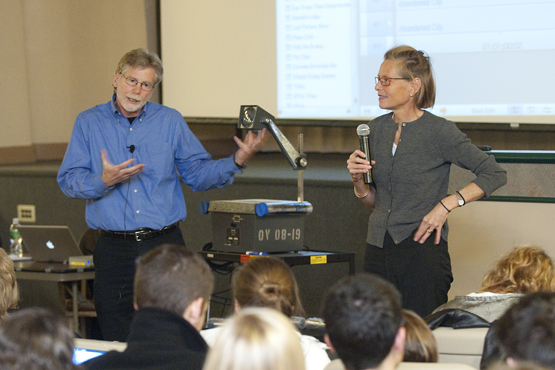One Class, One Day: COM’s World
The big introduction, 101, becomes film week

Class by class, lecture by lecture, question asked by question answered, an education is built. This is one of a series of visits to one class, on one day, in search of those building blocks at BU.
November, 2009. 9:27 a.m.
Students flow through the doors of Morse Auditorium, carrying coffee cups and checking text messages. They take seats among dozens of others already packing the rows. One student in the back wolfs down a banana before The World of COM begins.
More than 300 students are here for the wide-angled big picture, the mandatory course that introduces core disciplines in liberal arts and communications to College of Communication students. Guest lecturers from COM and the College of Arts & Sciences rotate through weekly, exploring a wide range of topics, from how people communicate to navigating career paths.
Two professors are setting up audiovisual equipment at the front of the auditorium. Student chatter bounces from the walls, subsiding only when Tammy Vigil, a COM assistant professor and associate dean, takes the podium.
“Film Week is this week,” Vigil says. Whooping and clapping with a collective “Yes!” is the reply.
She introduces two filmmakers from the department of film and television, Sam Kauffmann and Mary Jane Doherty, who will be the day’s guest lecturers. Kauffmann (COM’77), a professor, is working on a film about HIV in Uganda, and Doherty, an associate professor, is following three young dancers in Cuba.
Kauffmann frames the day’s subject: what goes into a great film? Most people think of good acting and a solid script. But as he explains, much more goes on behind the scenes.
For example, film angles are crucial. As he paces back and forth, arm sweeping for emphasis, he says directors must always keep the viewer in mind when choosing “the best seat for action.” To prove his point, he calls up School of Rock on a screen so massive it covers the entire auditorium stage. He asks students to pay attention to the editor’s shot choices.
 9:37 a.m.
9:37 a.m.
Lights out. “Oh, yes,” shouts a student toward the back. Jack Black and a classroom of children fill the screen. The movie flits between close-ups of key characters and a panorama.
Kauffmann dissects the scene when the lights go up, pointing out how the director offers at least 10 angles on a single classroom.
Doherty joins the discussion, launching her lecture on the “secret of filmmaking: the world of sound.” With a microphone clutched in one hand and a piece of paper in the other, she asks how students want to feel after a movie.
“Satisfied,” says a voice near the front of the room.
“Engaged,” calls another.
Before cuing up the next movie, Punch Drunk Love, Doherty asks the audience to pay attention to the sounds they hear—when they appear and their intensity.
9:49 a.m.
The room goes black. Suddenly Adam Sandler appears at a desk in a barren warehouse talking to someone on a phone. Few sounds creep into this vacuum-like space. The ringing of chimes pulls Sandler away from his conversation and outside the warehouse, where he witnesses an ear-splitting car accident.
The lights go up. Doherty asks when the greatest shift in sound occurred. The discussion is focused at the front of the auditorium; few of those seated in the back can hear what’s being said.
Three types of sound fill each film, Doherty explains: ambient tone, spot effects—or “sweeteners”—and voice. She explains how different sounds are used to engage the viewer. “This is understanding sound,” she says. “This is having control of the audience in an emotional sense.”
Lighting also enriches movie scenes. To prove the point, Doherty has Kauffmann cue The Man Who Wasn’t There. She asks students to note the lighting sources in the black-and-white film.
 9:57 a.m.
9:57 a.m.
Lights out. Laptops glow in the dark room, casting a pale light on students’ faces. Some toward the back close their eyes and slump low in their seats.
On the screen, Tony Shalhoub stands in a shower of light in the middle of an interrogation room. His eyes are hidden in shadow. On the scene’s fringes, other characters are barely visible.
Lights up. Doherty asks students what was involved in the set. Beyond a smattering of furniture, the main element was light pouring from an unseen source above Shalhoub.
The tardiest student in a class of 365 straggles in and takes a seat in the back. Doherty continues without noticing. She talks about eyes being “the beauty of the soul.” By taking away Shalhoub’s eyes, the director takes away his identity.
“It is never solely about what the audience can see,” she says. “It’s much more about what the audience can’t see.” The sound of furious keyboard clacking follows the professor’s words.
Kauffmann then talks about compressing time in film. An editor’s prudent cuts, he says, can condense a movie about a five-year war into two hours. He asks students how long it takes them to go up seven flights of stairs. One wagers a minute and a half. Another, four minutes.
Gene Hackman bests both of them in The French Connection.
10:06 a.m.
Everything goes black. A young Hackman flies up the staircase of an apartment building in pursuit of a rooftop sniper. His arrival time: five seconds. It takes him three seconds fewer to descend.
“He could have jumped and it would’ve taken longer,” Kauffmann says when the lights return.
Strong editing can also convey subtleties. In Searching for Bobby Fischer, the main character undergoes an emotional shift. Convincing viewers of that, Doherty says, is one of an editor’s toughest jobs.
 10:14 a.m.
10:14 a.m.
Lights out. An elementary-age Max Pomeranc and his father, Joe Mantegna, sit at the kitchen table for a friendly game of chess. Just as the game heats up, the screen goes black. No one says a word. Is this part of the lecture? Nope.
Kauffmann and Doherty fiddle with the laptop and podium controls for a couple of minutes before father and son reappear on the screen. The clip finishes with the boy victorious and the father convinced his son is a genius. Careful editing helped the audience connect those dots too, Doherty explains.
Several students begin to shift and stretch in their seats. Vigil maintains her stance at the back of the auditorium.
Wrapping up the lecture, Doherty and Kauffmann show a short clip from a student-made film called Abandoned. The four-person crew had had one semester of film study before launching an eight-week production.
“It’s important to see how far you can get with so few resources,” Doherty says.
10:31 a.m.
On the screen, a student actor manipulates computers inside an empty warehouse made to look like a space station. When the lights go out, he searches for a crewmate, only to find him covered in blood on the bathroom floor.
Kauffmann and Doherty open the floor to questions, pointing at people rather than calling out names. Questions trail off, and students start packing their bags. Vigil returns to center stage to lead the class in a round of applause for their guest lecturers. Then, according to class custom, Micha Sabovik, assistant dean for student services, makes announcements; there’s a raffle to view the Independent Film Channel’s most recent work, Anti-Christ, Sabovik (COM’96,’06) says.
10:46 a.m.
Class ended, students pour from rows and clog aisles, shuffling out with empty coffee cups. Some send text messages as they trudge along. A half-eaten banana lies in its peel on the floor of the last row.
Leslie Friday can be reached at lfriday@bu.edu; follow her on Twitter at @lesliefriday.
This Series
Also in
One Class, One Day
-
November 30, 2018
Breaking Bad Director Gives CAS Class the Inside Dope
-
October 31, 2018
Trump and the Press: We’ve Been Here Before
-
August 3, 2018
A Scholarly Take on Superheroes

Comments & Discussion
Boston University moderates comments to facilitate an informed, substantive, civil conversation. Abusive, profane, self-promotional, misleading, incoherent or off-topic comments will be rejected. Moderators are staffed during regular business hours (EST) and can only accept comments written in English. Statistics or facts must include a citation or a link to the citation.